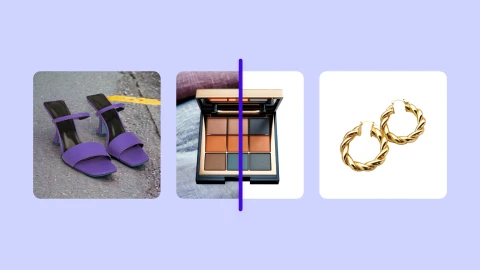Top things to sell on Etsy in 2025: a seller’s guide


Choosing the right product to sell on Etsy can mean the difference between struggling for sales and hearing that satisfying sales notification. With over 140 product categories and 9 million sellers, standing out requires being strategic.
In this guide, you’ll discover the best things to sell on Etsy, how to pick the right products, and the key steps to building a profitable shop. By the end, you’ll have a clear plan to turn your ideas into real sales.
💡 Create stunning photos for Etsy! With Photoroom’s AI tools, you can attract more customers and boost sales when you create high-quality product images →
Table of content:
11 best-selling products on Etsy
Here are the top-selling product categories on Etsy.
1. Craft Supplies & Tools

The craft supplies category has over nine million craft supply listings ranging from glittery embroidery threads to exclusive origami paper sets. Etsy is a paradise for DIY lovers. Crafting appeals to a broad audience because it allows anyone to express their creativity and make unique items they can proudly display.
The craft supplies industry is expected to grow to $55 billion by 2032. It’s a saturated but in-demand category that offers a wide range of product options and a low barrier to entry (you can source materials to sell without crafting skills).
Examples of Etsy sellers in this category
Cheery Little Sheep sells chunky wool and craft supplies.
Mora Approved sells DIY kits for a range of use cases.
Wax Stamp Finds sells kits for wax seal stamps.
2. Jewelry

With over six million items listed, jewelry is another saturated category on Etsy, but with a huge opportunity. We all have different tastes in fashion, meaning that you can find a market by niching down and specializing in a specific type of jewelry. You can sell minimalistic rings, woolen bracelets, flower-themed earrings, 60s-style necklaces, vintage collector pieces, artisan-crafted necklaces made from organic materials, and so much more.
Examples of Etsy sellers in this category
Pam East Designs sells hand-made earrings and necklaces.
Ula Jewellery Cornwall sells handcrafted jewelry made with gemstones and crystals.
Positive Vibes UK sells crystal jewelry.
3. Paper & Party Supplies

As long as humans exist, there’ll always be a party happening somewhere. From weddings and birthdays to inaugurations and luncheons, event organizers need party supplies to curate the right experience. This is where you can come in. Customers rely on Etsy to find paper and party solutions. This category includes bespoke stationery items, digital downloads for website themes, resumes, stickers, planners, quirky party favors adding an exclusive appeal, and several other items.
Examples of Etsy sellers in this category
Conscious Confetti sells biodegradable carbon-conscious confetti.
ADC Crafts sells personalized packaging.
Sew Shelley Crafts sells handmade crafts, stickers, and cards.
4. Home & Living

The home and living category is one of Etsy’s most profitable, and for good reason. Everyone loves a home that feels uniquely theirs. Think of handcrafted decor like macramé plant hangers, rustic wooden shelves, or personalized throw pillows. Products in this category do well when they combine functionality with a personal touch. This could be your niche if you can create items that turn everyday spaces into warm, inviting homes.
Examples of Etsy sellers in this category
Etna Lava Rock sells handcrafted ceramic art pieces.
Stacy Kitchen Decor sells handmade reusable kitchen towels, aprons, and bags.
Ever So Personal sells personalized door mats.
5. Weddings

Etsy thrives as a go-to for couples planning their dream weddings, where personalization is everything. Sellers succeed with products like custom invitations, hand-painted signs, or monogrammed bridal party gifts. Seasonal spikes in wedding planning make this category ideal for sellers who can offer something creative and customizable. If you can design or source products that help couples make their day feel one-of-a-kind, you’ll find an eager audience.
Examples of Etsy sellers in this category
Fizzbomb Keyrings sells handmade personalized keyrings.
Filterity sells customizable Canva templates, including wedding newspaper templates.
Diamond Stars Print contemporary wedding stationery.
6. Clothing

Etsy’s clothing category caters to shoppers looking for something they won’t find in stores. Sellers often thrive with hand-dyed shirts, boho-inspired dresses, or vintage clothing. If you’re skilled at creating or collecting wearable art that celebrates individuality, clothing could be your ticket to success. Adding a personal touch—like custom embroidery or made-to-order sizing—can also set your shop apart.
Examples of Etsy sellers in this category
Meta Awareness sells exquisite embroidery and unique sweatshirts.
Man In The Studio sells slow, conscious artisan clothing.
UNO Designs sells customizable T-shirts.
📚 Further reading:
7. Accessories

Accessories are a seller’s dream: lightweight, versatile, and always in demand. Shoppers love accessories that elevate their basic items and reflect their style. Popular products include jewelry boxes, custom tote bags, and passport holders. Accessories are a great category to explore if you can offer trendy or personalized items that are easy to ship.
Examples of Etsy sellers in this category
Ames Avenue Boutique sells a range of accessories, from beaded pens to passport covers.
Rachel Green Crafts sells hand-knitted accessories.
Ellie And Kobe sell keyrings, hair pins, and other accessories.
8. Bath & Beauty

The bath and beauty category is perfect for sellers who enjoy crafting indulgent, eco-friendly products. Think artisanal soaps, bath bombs in unexpected shapes, or organic skincare with clean ingredients. Buyers are drawn to items that feel like small luxuries, and you can provide products that elevate their daily routines into moments of self-care.
Examples of Etsy sellers in this category
With Love Indie sells personalized compact mirrors.
Elizabeth and Ernest sells personalized beauty gift boxes.
Mad About Nature Shop sells handmade bath soaps.
9. Art & Collectibles

If you search “Art” on Etsy, you’ll find everything from vintage prints to illustrations and oil paintings. The platform is a great place to dip your toes into online selling if you’re an artist or maker. Art and collectibles attract shoppers who want their walls, shelves, and spaces to tell a story. Popular products include digital prints, original paintings, and rare vintage items.
Examples of Etsy sellers in this category
The Art Of Nicholas sells custom family portraits and couple illustrations with pets.
Fur Family Studio sells art illustrations for pet lovers.
73 dface sells custom music, movies, maps, star maps, and sports prints
10. Toys & Games

Parents and gift-givers often turn to Etsy for toys and games that aren’t mass-produced. They buy pieces like Montessori-style wooden puzzles, soft handmade plushies, and custom board games. If you can craft quality toys that spark joy and engage the imagination, you’ll appeal to buyers who want more than the usual plastic options.
Examples of Etsy sellers in this category
Josh Toy makes wooden toys.
Kids Learning Toys makes educational pieces.
Backgammons sells backgammons and chess sets.
11. Pet Supplies

Pet owners treat their furry friends like family and always look for ways to spoil them. Some of Etsy’s top pet supplies include custom collars, personalized feeding mats, and handmade pet beds. This category has huge potential if you can make or source products that are both functional and fun.
Examples of Etsy sellers in this category
Left Coast sells wooden food bowls and stands.
Polly’s Dog Treats sells handmade treats for dogs.
KBS Pets sells tree towers for cats.
Why sell on Etsy?
Think Etsy is just for hobbyists? Think again. The platform hosts a variety of business owners and shoppers, bridging the gap between creative ideas and market opportunity.
Here’s why Etsy is one of the most strategic e-commerce platforms for creative entrepreneurs.
Reach buyers without paid ads: Unlike platforms prioritizing pay-to-play visibility, Etsy’s search algorithm rewards relevance and engagement. A well-optimized listing has a fair chance to thrive without needing a big ad budget.
Tap into cultural trends: Etsy aligns closely with cultural movements like sustainability, handmade craftsmanship, and supporting small businesses—trends buyers value deeply today.
Sell diverse products: Etsy isn’t just for crafts or physical products. You can sell printables, digital planners, and templates and scale your income streams without inventory management.
Leverage buyer feedback: Etsy’s review system and direct messaging allow you to get real-time feedback, fostering stronger customer relationships and informing product improvements.
Ride seasonal demand: High demand for holiday gifts (the most popular shopping practice), wedding decor, and event-specific items let you plan around predictable spikes.
Benefit from a strong community: Selling on Etsy means joining a network of solopreneurs who share insights, collaborate, and celebrate craftsmanship. Etsy also promotes sellers globally, spotlighting small businesses in marketing and public campaigns.
Reach a global audience: With over 91.6 million active buyers, Etsy connects your products to a worldwide audience actively seeking meaningful, unique items.

How to choose the right products to sell on Etsy
Now that you know what to sell on Etsy, how do you choose what’s profitable? Here are three simple steps to help you identify potentially successful products.
1. Understand trendy vs. timeless products
Selling on Etsy starts with understanding the balance between trendy and timeless products. Trends can bring quick wins—think seasonal items, popular themes on TikTok, or emerging designs spotted in social media feeds. But trends fade, so it’s important to pair them with timeless offerings buyers will want year-round, like personalized gifts, home decor, or jewelry.
Here are some effective ways to spot trends:
Search Etsy’s site. Use Etsy’s “best selling” page to uncover popular categories, trending keywords, items with multiple reviews, or the Star Seller badge. You can sort the page by “top customer reviews” to get a sense of Etsy sellers who are doing well.
Analyze Google Trends to assess people's interest in certain topics over time. You can see whether the public interest in a potential product category is rising, declining, or consistent.
Browse community forums or Reddit groups where buyers talk about what they love.
Search social media platforms like Instagram, Pinterest, and TikTok to gather insights into up-and-coming trends and customer preferences.
Research other marketplaces like Amazon, eBay, or Alibaba for product categories that are booming. Keep an eye on their bestselling lists to see broader consumer behavior beyond Etsy.
With trends, the goal is to find items you can put your unique spin on, not to copy what’s hot. Timeless products, on the other hand, succeed because they solve enduring needs. Ask yourself: Would buyers want this product five years from now? By offering a mix of both, you create a sustainable shop that attracts repeat customers even after trends evolve.

2. Select your niche
Instead of trying to appeal to everyone, focus on a specific type of buyer. For instance, instead of “home decor,” think “boho-inspired planters for plant lovers” or “eco-friendly wedding decor for minimalist couples.” Buyers come to Etsy for unique finds, and your niche is where uniqueness meets focus.
Here’s how you can define your niche:
Identify what excites you most. It could be anything from watercolor painting to collecting plant seeds from rare locations.
Study trends outside Etsy, like Pinterest mood boards, magazine editorials, or YouTube DIY communities to explore untapped niches.
Research your competition to see what similar sellers offer and ways you can stand out. Visit their Etsy shops, read their product descriptions, and, most importantly, look at their reviews. What are buyers loving? What’s missing? These gaps are your opportunity.
Research Etsy listings. For instance, if one niche like “flower prints” has more than 900,000 listings, it might be harder to break through the competition.
Research ease of entry. Will the product require a huge amount of capital to start? Can you create a network of suppliers if you aren’t producing? These questions help you understand your ideal first steps for launching products in your chosen niche.
Showcase your niche. Once you’ve decided on a niche, create simple visual brand assets that immediately communicate what you sell. You can use AI tools, which can help you create custom logos, make sample product photos, develop your brand kit, and even build your entire visual brand identity when you’re ready.
Successful sellers know that the best niches aren’t overpopulated; they are specific, easy to venture into, and can be validated through market research.

Laura, owner of Etna Lava Rock caters to an audience that loves handcrafted stone and ceramic art.
3. Balance passion with market demand
Loving what you sell is important, but success comes from aligning that passion with what people actively want to buy. Instead of chasing trends, position your products in a way that makes buyers see them as essential.
Here’s how to balance what you love with customers’ interests:
Sell emotions, not just products. People buy based on feelings. Does your product help them express love, reduce stress, or feel unique? Frame it around an emotional need.
Spot buying patterns. Focus on items that sell consistently, not just seasonal bursts. Look for repeat-purchase products like refills or collectibles.
Fix small frustrations buyers ignore. Read reviews in your niche. Are buyers looking for sturdier materials, better colors, or an eco-friendly option? Small upgrades can create big demand.
Test before going all in. Start with limited editions or digital pre-orders to gauge demand before committing to full production.
Think long-term. Categories like wellness, sustainability, and personalization are growing. Position your shop for future demand, not just current fads.
Passion matters because it drives your creativity and keeps you motivated, but the market determines how your products perform. By balancing both, you position yourself to create items that not only excite you but also resonate with buyers and generate sales. The sweet spot lies in merging your skills with what customers need.

Digital products by Rachel Jimenez, who sells printables on Etsy and only became successful after she reviewed her customer stats and “was surprised to find that a series of budgeting templates I created sold consistently. In a moment of clarity, I knew I couldn’t afford to spend time on [making products] that wouldn’t get results,” she told CNBC.
Things to know before starting an Etsy shop
Before launching your shop, let’s look at the cost of selling on Etsy, including listing, taxes, and additional fees.
How much does Etsy charge for listing?
Etsy takes a $0.20 fee for every item you list in the marketplace. You’re only charged when you create or renew a listing, not for editing one. The fee applies whether or not anyone buys your items—except for private listings, which Etsy only bills you for if they sell.
Etsy listings expire after four months, which means that if you don’t sell a listed product within that timeframe, the platform will still charge you to list it again. If you list multiple quantities of an item, you pay $0.20 upfront and another $0.20 each time one sells.
But the platform doesn’t charge you if you list your items on your Pattern site—a custom website you can create with Etsy to sell your items outside the Etsy marketplace.
💡 PRO TIP: Consider factoring these expenses into your pricing to sustain your business financially.
Do Etsy fees include business taxes?
Like any other business, operating an Etsy shop also requires adherence to tax laws based on your geographical location, which means reporting the income you earn through sales transactions when filing taxes each year.
This isn’t just important because it’s what law-abiding citizens do. Failing to pay adequate taxes could lead to penalties and harm your reputation. So, while figuring out product ideas to sell on Etsy, don’t forget to look into tax obligations.
Etsy handles taxes in some cases. For most US orders, Etsy calculates, collects, and pays sales tax for you, while sellers in Canada or other countries may need to include taxes in their prices. Etsy also collects VAT for digital goods in certain countries and may charge VAT on seller fees based on your location. Always categorize your listings correctly for accurate tax calculations.
Additional fees on Etsy
Apart from listing fees, there are additional costs associated with selling on Etsy that you should be ready for:
Transaction fees. When an item sells, Etsy charges you a transaction fee, which is 6.5% of the price displayed for each listing.
Shipping transaction fees. Based on what you bill customers for shipping, Etsy charges a shipping transaction fee of 6.5%.
Setup fee. You might be required to pay a one-time fee between $15-$29 to set up your Etsy shop.
While understanding the overall costs of selling on Etsy may feel overwhelming at first, this knowledge will help you set competitive prices that generate profits. Encourage repeat customers by offering high-quality products and building strong customer relationships—it’ll make it all worth it!
🤝Friendly reminder: A successful Etsy shop isn't built overnight; persistence, patience, and carefully considering these operational aspects will help your business succeed.
Here’s an overview of all of Etsy’s fees:
| Fee type | Cost | When charged |
|---|---|---|
| Listing fee | $0.20 per listing | At the time of publishing or renewing a listing. |
| Set-up fee | $15 - $29 | At the time of shop setup after confirmation. |
| Transaction fee | 6.5% | At the time of sale. |
| Etsy ads fee | Based on budget; charged per click. | Recurring, based on ad clicks and budget. |
| Offsite ads fee | 12% or 15% of total order amount from attributed sales via offsite ads. | At the time of attributed sale via offsite ads. |
| Subscription fee (Etsy Plus) | $10 per month for additional tools and credits. | Monthly, on the subscription cycle date. |
| Payment processing fee | Varies by country; a percentage of total sales including tax and shipping. | Per transaction through Etsy Payments. |
| Delivery fees | 6.5% of shipping fee. Cost of postage labels depends on carrier and package details. | At the time of sale or label purchase. |
| Regulatory operating fee | Fixed percentage of the total sale. Cost varies. | Per transaction in specified countries. |
| Pattern fee | $15 per month after a 30-day free trial. | Monthly, starting after free trial. |
| Currency conversion fee | 2.5% on sales. | Automatically on sales requiring conversion. |
9 Best practices for your Etsy shop
1. Provide great customer service
Etsy is a community-based marketplace that thrives on personal connections and high-quality customer service. It's not just about selling the best items; it’s also about providing the best buying experience. Always respond quickly and professionally to customer queries, resolve issues amicably, and ship items on time. This responsiveness builds trust and generates repeat business.
2. Optimize your product listings
Proper optimization involves using keywords in your tags, titles, and descriptions. Keywords significantly influence how your products appear in search results. Use clear, descriptive tags and titles with relevant keywords customers might search for. For example, instead of "Pretty Rug," use "Handmade Wool Rug with Floral Design.”
For product descriptions, start with the most important information and include keywords and details to answer potential customer questions (e.g., size, material, care instructions, international shipping). Your end goal is to make sales, so provide information that makes it easy for customers to understand your offer and shop from your store.
3. Use high-quality product photos
An Etsy survey revealed that high-quality photos are very important to 90% of shoppers when deciding whether to buy a product. Even more important than the retail price, shipping costs, and reviews.

High-quality photos signal professionalism and build trust, helping you convert browsers into buyers. But creating professional-quality images can feel overwhelming when you don’t have expensive equipment or hours to spend editing. That’s where AI-powered tools come in.
With the right AI visual platform, particularly those built for business owners like Photoroom, you can take your pictures from basic to professional in minutes. These tools automate several stages of the photography process, require zero editing skills, and save you valuable time.
Here are some ways you can elevate your photos with AI-powered tools:
AI Upscale: Sharpen blurry photos and improve resolution to make your products stand out. Great for transforming smartphone shots into professional-looking images.
AI Retouch: Easily remove distracting objects or imperfections that take the focus away from your product.
Background Remover: Get clean, distraction-free backgrounds that make your products pop, especially when showcasing jewelry, clothing, or small decor.
AI Backgrounds: Need a more eye-catching scene? Instantly generate custom, professional backgrounds to match your product’s vibe.
AI Shadows: Add realistic shadows to give your images depth and a polished, 3D look.
Resize tool + AI Expand: Create images in multiple dimensions for Etsy listings and other platforms. The AI Expand feature fills white spaces, making every shot look complete.
Batch Mode: Save time by editing multiple photos at once.

“I have had an Etsy store since 2017, and Photoroom has been a game changer for me,” says Rachel, owner of Rachel Green Crafts and a star seller on Etsy. “Before, I had to use a fabric backdrop, which didn’t look good. But being able to switch to add white backgrounds and resize images with Photoroom means I can pretty much take photos to any platform anywhere now.”
📚 Don’t miss:
4. Set competitive pricing (but keep profits in mind)
To find a pricing strategy that’s both competitive and profitable, you need to understand market expectations. For this, simply research prices by other Etsy sellers within the same category as your merchandise. You can also research pricing in other marketplaces for inspiration.
💡 PRO TIP: Profitability doesn't necessarily mean you have to set higher retail prices. Affordable items with high turnover rates can also generate substantial profits. So always keep the health of your wallet and business in check while devising pricing strategies.
“I always like to say, a fast penny is better than a slow dime,” says Humberto Leal Treviño, founder and CEO of Vintage Packs. “Volume is always going to beat us, so we try to price everything to move. We offer three t-shirts for 45 to 50 bucks, while everyone else sells one shirt for 50 bucks.”
5. Grow your email list
Building an email list is one of the most effective Etsy shop best practices. By capturing contact information from visitors and buyers, you're creating a gateway to promote new offerings, share discounts, or simply engage with your customers on a more personal level (and more frequently).
6. Promote your Etsy products on social media
Social media is a powerful, low-cost way to drive traffic to your Etsy shop. Leverage platforms like Instagram, Facebook, TikTok, and Pinterest to share images and related content about your products and reach potential customers.
Standing out on social media requires crafting posts that tell a story and capture attention. If social media content isn’t your bread and butter, you can explore AI-powered tools to craft your content.
For instance, you can enhance image quality with an AI Upscaler, use prompts to create stunning posters, use a background eraser to remove backgrounds from product images, change image backgrounds, and so much more.
Here’s a poster I created using the poster maker in Photoroom.

📘 Don’t miss: 12 creative ways to use an AI background remover for catchy ads
💡 Make quality visuals: Attract customers to your shop with strong product photos and designs →
7. Host in-person pop-up events
According to these pop-up retail statistics from Capital One, 80% of retailers that have opened a pop-up shop considered it a success; 58% plan to open another pop-up. And 32% of pop-ups are from e-commerce businesses.
While you may have never considered physical sales for your online Etsy business, don't underestimate the power of connection that comes with in-person interactions. Hosting pop-up events can give your brand visibility and help create lasting relationships with local customers.
In fact, according to Statista, over half of survey respondents in the United States shopped at pop-up shops to find unique products and enjoy unique experiences. Many consumers also went to pop-ups because they were curious and wanted to support local and independent businesses.

8. Encourage customer reviews
In a survey by eRank, 59.4% of shoppers say that customer reviews are among the top factors they consider when deciding where to shop on Etsy. Positive reviews top the chart when it comes to building trust among new customers. It's proof that others have tested your products and found them fulfilling.
Etsy shoppers have 100 days to leave a review. If you’re building an email list, you can segment subscribers based on buying behavior and encourage past customers to leave a review for their purchases on your Etsy shop. You can also weave these customer testimonials into future marketing materials (social posts or email campaigns)—shoppers love seeing real-world applications and satisfaction from actual customers.
9. Create a clear shipping and returns policy
A transparent shipping and returns policy eliminates the guesswork for customers and provides clear guidelines on how transactions will occur post-purchase. This creates a sense of safety around purchases from your store, leading not only to conversions but long-term customer loyalty.
Pros of selling on Etsy
Reach the right audience. Etsy gives you access to a global audience of buyers seeking unique craft supplies, handmade jewelry, home decor, and more. If you’re selling these types of items, Etsy could be your marketplace.
Launch your store with ease. Setting up an Etsy shop is relatively straightforward compared to creating an e-commerce website from scratch—which can involve complex steps such as domain acquiring and SSL certificate arrangements among others. Etsy’s range of seller tools makes it easier to manage your shop, including marketing, analytics, and educational resources to grow your business.
Tap into a trustworthy platform. As a well-established platform, Etsy has built a trusted reputation for buyers and sellers over the years.
Get community support. You’ll have access to community forums where sellers exchange ideas, offer advice, and share experiences, something that’s not always available for standalone online stores.
Cons of selling on Etsy
Complex fee structure. The most profitable items on Etsy require paying listing fees (0.20 USD per item), transaction fees (5% per sale), and added fees for options such as promoted listings. This could whittle down profit margins, especially for products with higher manufacturing costs or low retail prices.
High competition. Since it’s easy to set up shop, you’re up against a lot of entrepreneurs and makers. You may find yourself in a pool of competitors selling similar products, which can be an enormous challenge if you don't have a niche product.
Less control. Compared to owning an independent website, you don’t have control over certain aspects like detailed customer data or customizing your store design.
Policy changes. If something happens to Etsy, say sudden changes in policy or a shutdown, it may affect your business. Not having sole control of your income stream can be risky.
Are you ready to start selling on Etsy?
Selling online can sometimes seem like an uphill struggle, but it also paves the path for new opportunities. While considering what to sell on Etsy to make money, don't overlook the importance of building a consistent brand identity in every step you take.
Consistent, high-quality visuals attract customers in crowded marketplaces and social media networks flooded with similar content. Photoroom is here to help. Enhance your product images with easy-to-use AI photo editing tools (on the Web or your smartphone — Google or Apple) to transform your Etsy product listings from good to extraordinary!
FAQs on things to sell on Etsy
How to start a business on Etsy?
Starting a business on Etsy is simple. First, create a free account and open your shop. Choose a shop name that reflects your products. Then, list your items with clear descriptions, competitive pricing, and high-quality photos. Set up your payment options and shipping details. Finally, promote your shop through social media and online communities to attract customers.
How to succeed on Etsy?
Success on Etsy comes from offering quality products and creating a great shopping experience. Here are some tips to help you grow your shop:
Use great photos: High-quality pictures grab attention and make your products stand out.
Write clear descriptions: Include details like size, materials, and how your product is used.
Research keywords: Use relevant terms in your titles and tags so buyers can find you easily.
Provide excellent service: Respond quickly to messages and ship orders on time.
Market your shop: Promote your products on social media, blogs, or local events.
Track trends: Stay updated on popular items to meet changing customer demands.
What are the most popular things to sell on Etsy?
Buyers on Etsy love products that are unique, handmade, or personalized. Here are some of the top-selling and easy things to sell on Etsy:
Jewelry and accessories, including custom pieces.
Personalized gifts that feel special and thoughtful.
Home decor like candles, wall art, and plant hangers.
Wedding items like invitations, decorations, and favors.
Digital downloads such as printables and templates.
What sells well on Etsy?
Etsy has a wide range of categories that consistently perform well. Here are some of the best things to sell on Etsy:
Craft supplies and tools
Jewelry
Paper and party supplies
Home and living
Weddings
Clothing
Accessories
Bath and beauty
Art and collectibles
Toys and games
Pet supplies
How to sell digital products on Etsy?
Start by creating something valuable, like templates, printables, or art files. When listing your product, upload high-quality digital files and write clear descriptions explaining what buyers will receive. Use keywords to make your product searchable and attractive. Promote your digital downloads on social media to reach a wider audience.





















